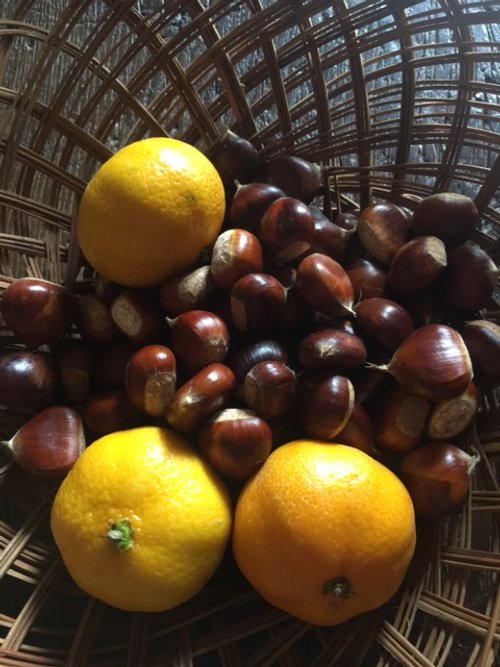November 2023
Since mid-October, chestnuts have been dropping into the garden from a tree in my neighbours’ field across the lane. In principle, what falls in the field is of course theirs, but what falls in the lane, which is a public right of way, or into my garden, can be happily scavenged. The chestnut windfalls that end up in my kitchen are roasted on the top of the wood-stove (a Spanish-made, cast-iron one that came with the house) or boiled, to be eaten with milk and sugar in the local fashion.
Chestnuts are the mainstay of the vast wild area known as ‘O Courel’ that borders the Camino frances from O Cebreiro to Triacastela, and extends all the way to Quiroga and the river Sil to the south. Since time immemorial, these huge mixed forests have provided human and animal sustenance, but today, when the size and quality of the chestnuts they produce is recognised all over Europe, the careful management of chestnut plantations offers their owners a reliable cash crop. Autumn in the Courel sees whole families, old and young, grandparents and cousins, turn out to gather chestnuts, filling the sacks that are then sold at so-much per kilo to the agents of supermarkets and export companies. Some proprietors have taken to milling chestnut flour on a commercial basis, to supply the artisans whose cakes, breads and other baked goods can now be found in shops all over Galicia.
Years ago such luxury products were unknown: chestnut flour was a staple for the families lucky enough to own the trees, but it was the food of last resort for everyone else, especially in years when the rye and wheat harvests were poor. A former resident of O Cebreiro once told me how, aged twelve, he’d accompanied his father and two other men on an expedition to buy chestnut flour at a time of great scarcity. Mounted on mules and entrusted with the combined funds of their neighbours, the four got as far as Leon before finding anyone who had flour to sell. The return journey was made along lesser-known byways, the theft of the precious commodity being a very real risk in such hard times. Arriving home marked a coming of age, as the flour was divided among the villagers, and appetites, the boy’s included, assuaged by chestnut soup, bread and filloas, or crepes. Everyone is prosperous now, and that ‘boy’ is nearly 80, but still can’t resist picking up any chestnuts he spies on his daily walks around a big city.
Winter sustenance for birds

